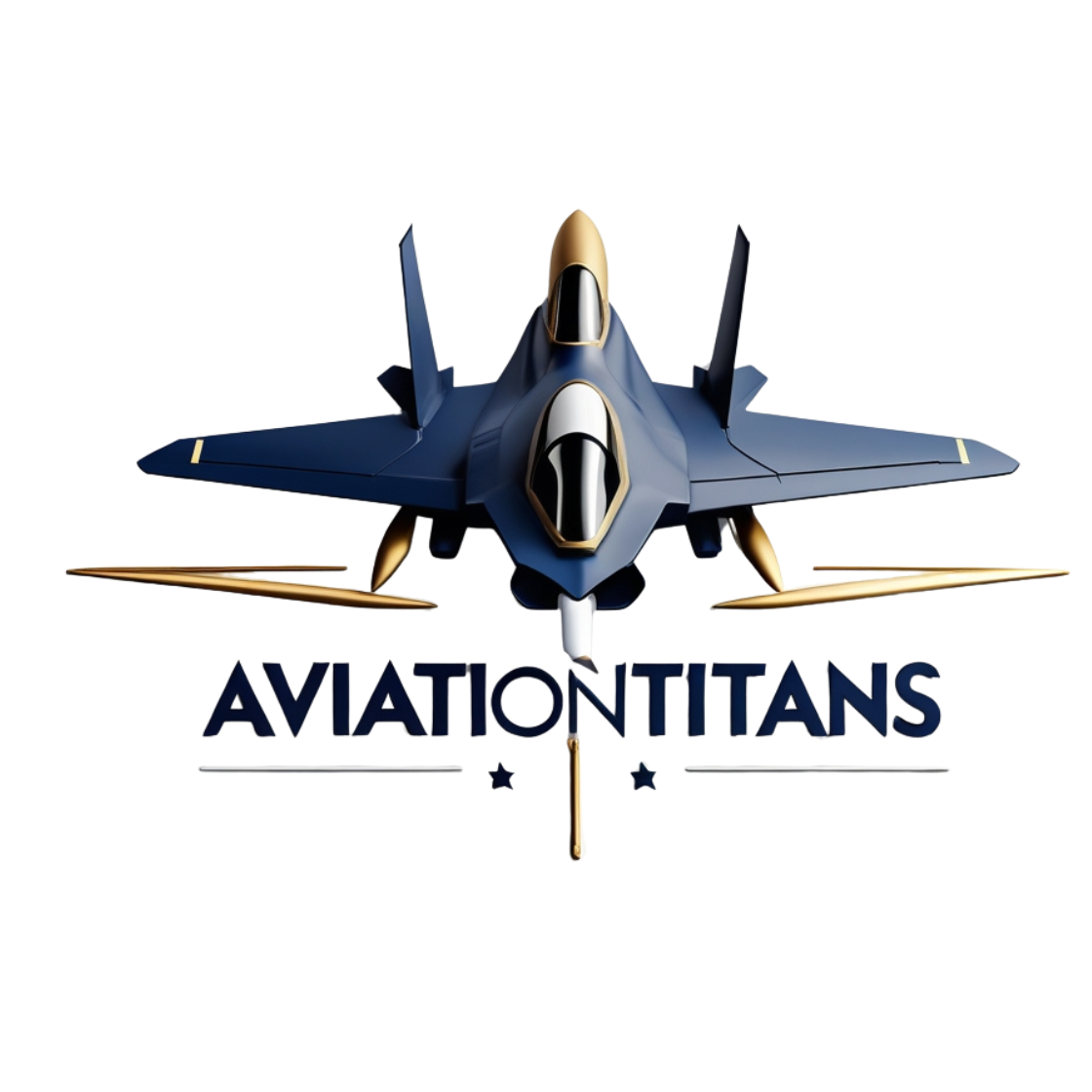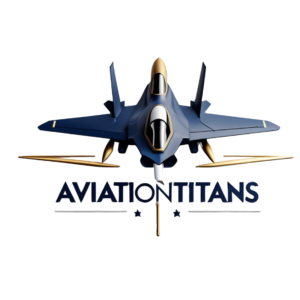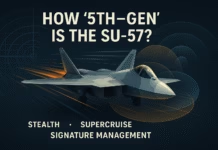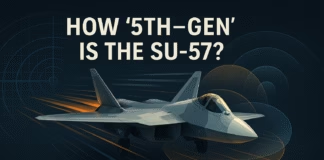Why the F135 was a breakthrough—until the mission outgrew it?
Pratt & Whitney’s F135 gave the F-35 the thrust, reliability, and sustainment backbone a stealth, sensor-rich fighter needed. But fifth-gen jets didn’t stay “fifth-gen” for long. Each software drop added hotter processors, bigger radar duty cycles, and more electronic-warfare/power loads. Thermal management—not just thrust—became the limiting factor. That’s why propulsion conversations now revolve around how to move more heat, more efficiently, while still boosting range and acceleration.
Enter two game-changers: ceramic matrix composites (CMCs) and adaptive-cycle architectures with much bigger built-in heat sinks. Together, they’re shaping the propulsion jump from the F135 era to the engines that will power sixth-generation fighters.
CMCs 101: hotter, lighter, tougher where it counts
Traditional nickel superalloys are remarkable—but CMCs take the hot-section fight further. Made from ceramic fibers embedded in a ceramic matrix, these components:
- Run hotter without losing strength, enabling higher turbine-inlet temperatures (more thermal efficiency and specific thrust).
- Weigh less than metal parts, trimming rotating mass and easing cooling air demands.
- Reduce cooling bleed, freeing up air for the core (thrust) or for—even better—airframe thermal management.
In practical terms, swapping metal shrouds, vanes, and certain combustor parts for CMCs means you can push temperature margins and shrink the amount of “cold” air you must steal from the compressor just to keep parts alive. That pays off twice: better core efficiency and more cooling capacity for the jet’s electronics and mission systems.
Want a primer from first principles? NASA’s materials work explains why high-temperature ceramics are a pillar of next-gen turbines (see NASA—High-Temperature Materials & Structures).
External: NASA High-Temperature Materials
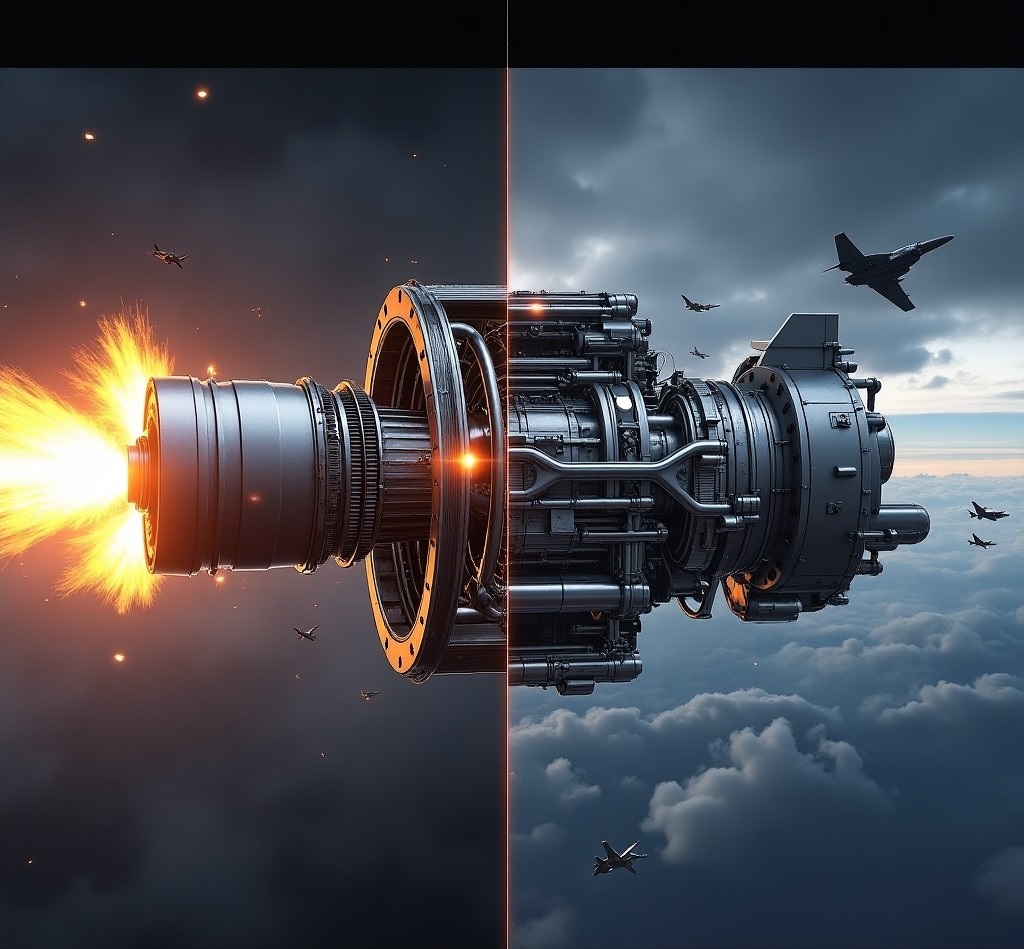
Why adaptive-cycle matters more than “just” more thrust
A classic fighter turbofan balances two needs: high-thrust (low bypass) for combat and high-efficiency (higher bypass) for cruise. Adaptive-cycle engines add a third stream of air and variable geometry so the engine can “adapt” between those states—and divert air where it’s most valuable at that moment:
- Fuel burn ↓ / range ↑ in cruise with more bypass-like flow.
- Thrust ↑ / acceleration ↑ in combat with more core flow.
- Thermal headroom ↑ by routing that third stream through heat exchangers, turning the engine into a giant, controllable heat sink for avionics and sensors.
GE Aerospace’s publicly described XA100 demonstrator and Pratt & Whitney’s adaptive efforts illustrate how this works in practice for fighters; both emphasize gains in fuel efficiency, thrust, and thermal management beyond today’s fixed-cycle designs.
Cooling is the quiet superstar
Power is nothing without cooling. Modern fighters carry:
- Bigger AESA radars with higher duty cycles
- High-power EW suites and towed decoys
- Hotter mission computers and open-systems avionics
- Electrified actuation and bigger generators that themselves dump heat
Legacy architectures used small heat exchangers and fuel as a heat sink; when the fuel warmed up, thermal margin vanished. Next-gen engines pair larger, more tunable heat exchangers with that third stream to dump heat efficiently—even late in a mission when fuel is hot. Pair this with CMCs that need less internal cooling air, and you free up airflow to move heat out of the airframe instead of babysitting turbine metals.
For a sense of how the U.S. Air Force frames the need, check its public overviews of Adaptive Engine Transition/Next-Gen Adaptive Propulsion—the throughline is power + thermal for future sensors and weapons. U.S. Air Force — Adaptive Engines (overview)
What changes in the cockpit and on the ramp
You won’t see the materials, but you’ll feel the effects.
For pilots
- Longer legs: Adaptive efficiency means more persistence on station or more range with the same tanks.
- Higher “fight power” availability: Better heat rejection lets mission systems run harder, longer, with fewer throttle or timeline compromises.
- Stronger hot-day performance: Higher temps and lower bleed improve acceleration and climb at high density altitude.
For maintainers
- Fewer hot-section headaches: CMC durability reduces thermal distress cycles; less cooling bleed can cut coking and varnish in certain pathways.
- Smarter trend monitoring: Sensors + digital twins spot outliers early (vibration, EGT margin, tip-clearance creep), so you swap fewer modules “just in case.”
- Sustainment wins: Lower cooling bleed and weight can reduce fuel burn across the fleet—small percentages add up to millions in O&S savings.
F135 upgrade vs. clean-sheet: two paths, one goal
There are two near-term philosophies for jets in service and those arriving next:
- Upgrade today’s core (e.g., the F135 Engine Core Upgrade concept) to add hot-section efficiency, durability, and limited thermal improvements without redesigning the entire engine bay. This is attractive for controlling integration risk and cost on fielded airframes.
External: Pratt & Whitney — F135 Modernization/ECU - Field adaptive-cycle engines on new platforms (and possibly selected retrofits) to unlock big thermal headroom, range, and thrust—key for sixth-gen. GE’s XA100 data and public Air Force statements around Next-Gen Adaptive Propulsion (NGAP) show where this is headed for NGAD-class fighters GE Aerospace — Adaptive Cycle Overview.
Think of ECUs as bridge upgrades for fifth-gen fleets, and adaptive engines as the endpoint for sixth-gen designs that must power hungrier sensors, directed-energy concepts, and collaborative combat aircraft.
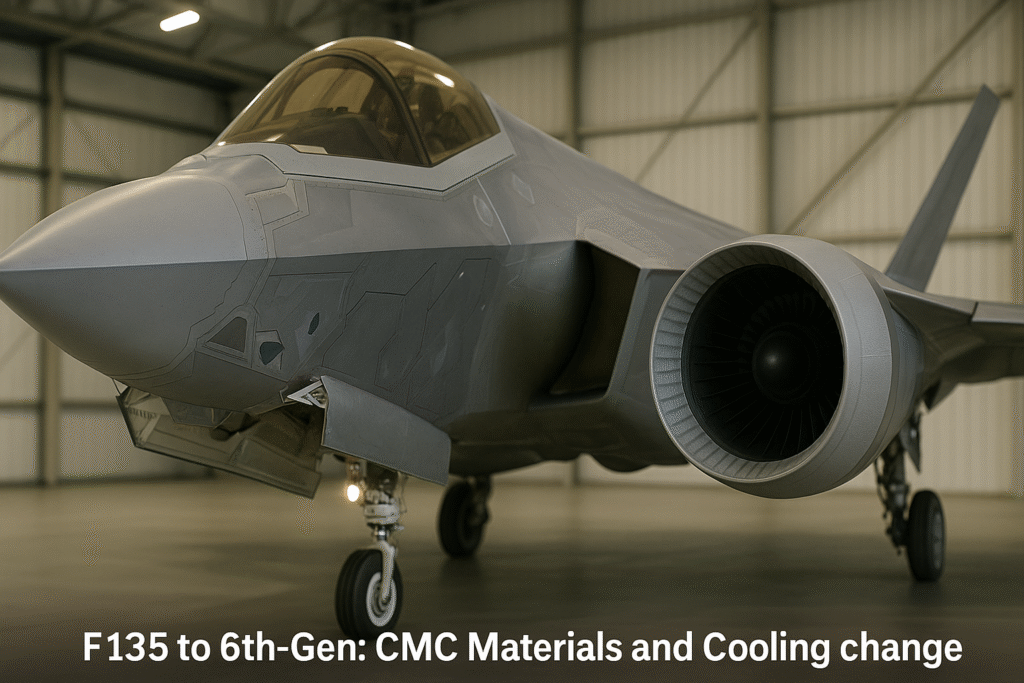
The CMC + cooling flywheel
These technologies reinforce one another:
- CMCs → hotter core and less bleed → more air to move heat
- Adaptive third stream → bigger heat sink → avionics can run harder
- Lower bleed + lighter parts → better specific fuel consumption → more range or payload
- Higher allowable temps → more thrust at combat settings without sacrificial durability
That “flywheel” is why propulsion sits at the center of sixth-gen trade studies. It’s not just “more pounds of thrust,” it’s how effectively the engine supports the airplane’s power and thermal budget.
Risks and tradeoffs (what engineers lose sleep over)
- CMC manufacturing & repair: Industrializing high-quality CMCs at fighter volumes is non-trivial. Field repairability and spares provisioning demand new MRO playbooks.
- Integration complexity: Adaptive engines change inlet/duct/duct-bleed dynamics and heat-exchanger packaging. Airframe designers must co-optimize bays, doors, and RAM-air paths so cooling works across the envelope.
- Sustainment forecasting: Digital twins need clean data. If fleets under-instrument, predictive models lose accuracy and reversion to “calendar-based maintenance” creeps back in.
- Cost vs capability: ECUs are cheaper to field in the near term; adaptive engines promise more capability for new jets. Program managers must align budgets, timelines, and test resources with real operational needs.
What to watch between now and first sixth-gen deliveries
- Thermal budgets in mission software: Are radar/EW duty cycles still capped by heat late in sorties—or are caps easing as new engines and heat exchangers arrive?
- Generator/output upgrades: Power generation often rises alongside cooling. Look for higher kW ratings and smart power distribution that prioritize mission systems without browning out the jet.
- Sustainment metrics: Hot-section life, on-wing time, and fuel burn trends will tell you if CMCs and bleed strategies are paying off across squadrons—not just on demo engines.
- Flight-test telemetry leaks (the legal kind): Public comments about range gain and thermal headroom are more meaningful than headline thrust numbers.
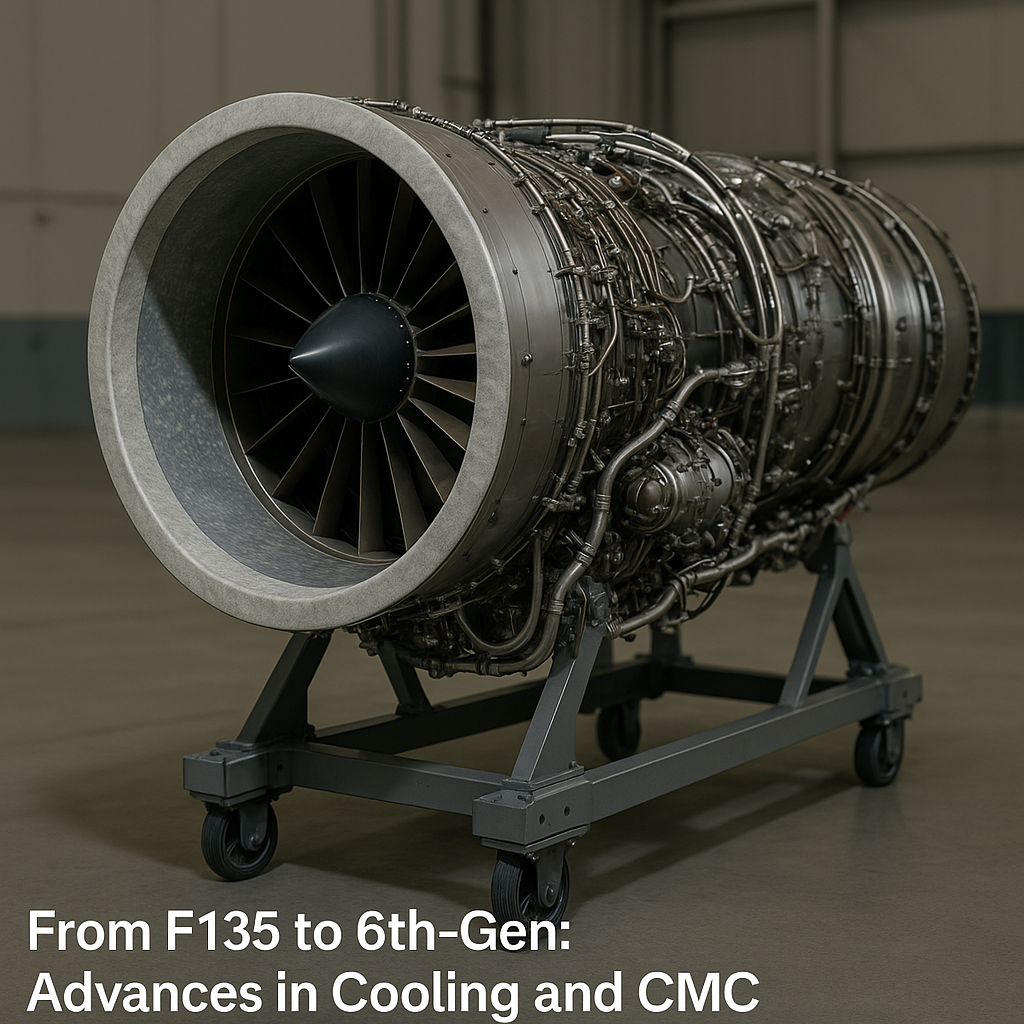
Bottom line
The step from the F135 era to sixth-generation propulsion isn’t about one magic part. It’s a system-level rethink: CMCs push the thermal ceiling; adaptive-cycle engines give pilots more range, thrust, and a controllable heat sink; and smarter power/thermal management keeps the whole jet inside limits when sensors are screaming. Put together, they enable the missions that next-gen fighters are being asked to fly—longer, hotter, and with more electrons flowing than ever.
🔗 References & Sources
- F-35 Lightning II – Lockheed Martin
- F-22 Raptor – Lockheed Martin
- Pratt & Whitney – F135 Engine
- XA100 Adaptive Engine – Pratt & Whitney
- Eurofighter EJ200 Engine
- GE F404 – GE Aerospace
- U.S. Air Force Fact Sheets
- Lockheed SR-72 Hypersonic Program
Keep exploring:
Internal: Aircraft — Military Aircraft • Aircraft — Experimental & Future Aircraft • News — Market Trends
